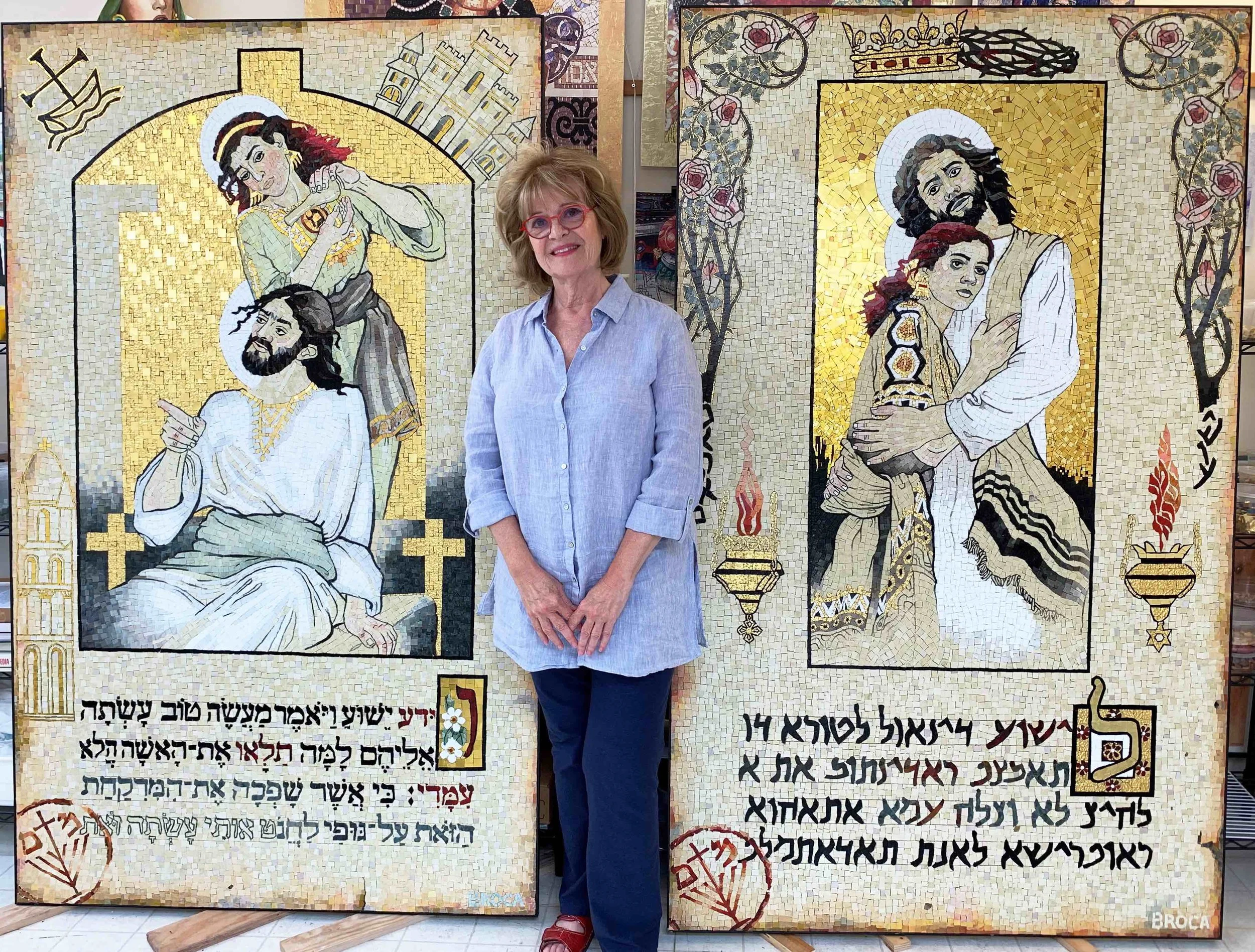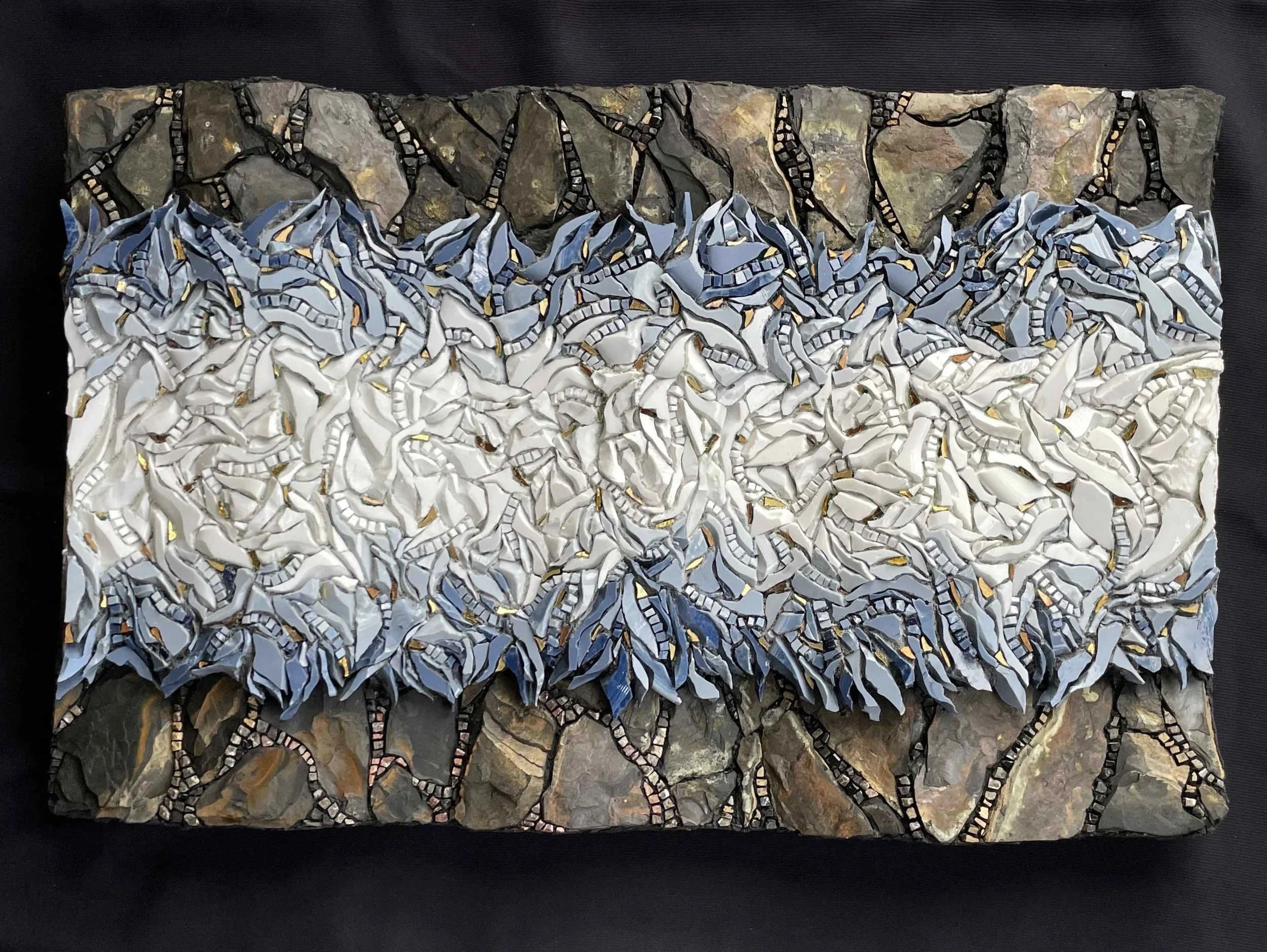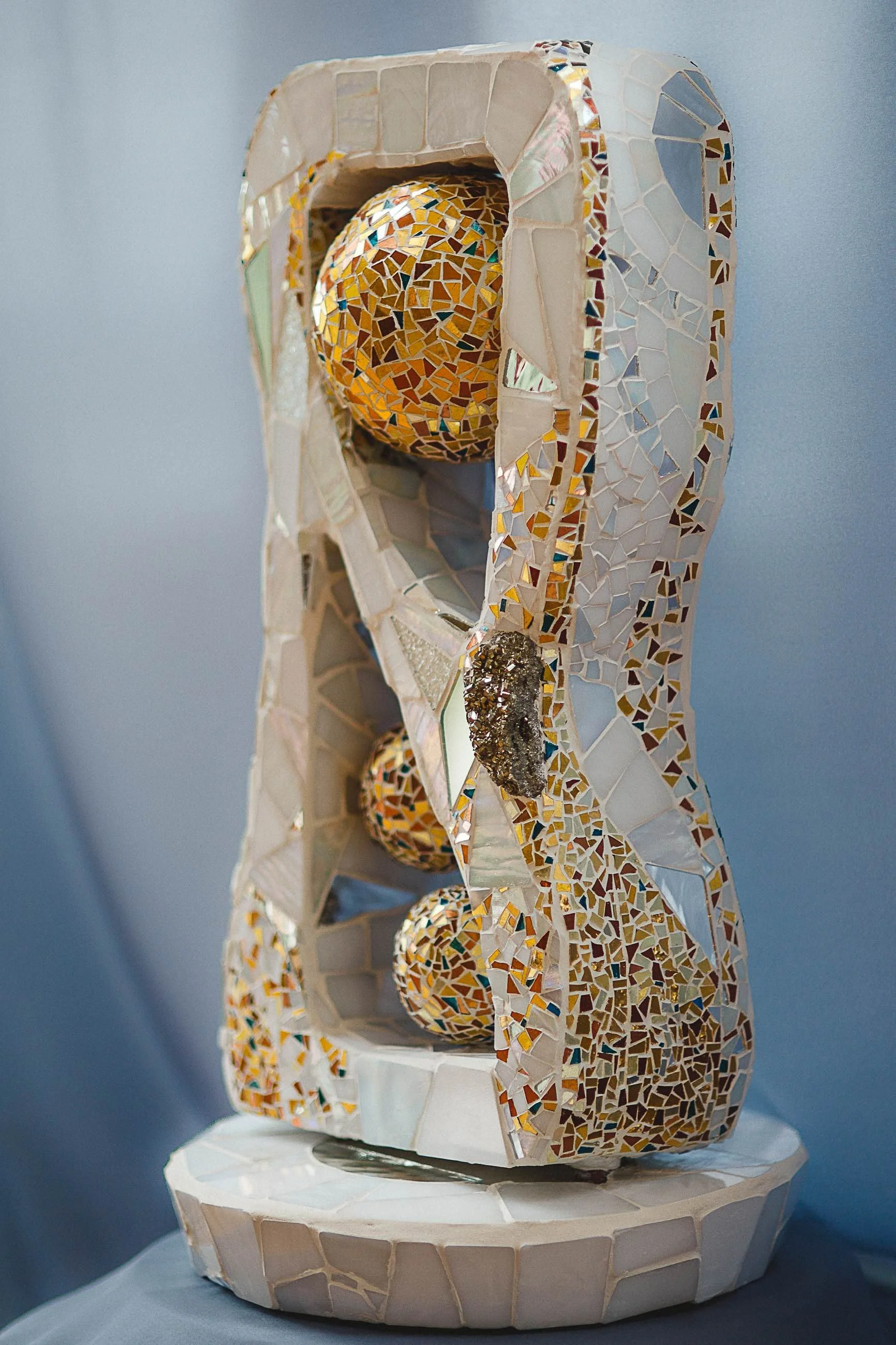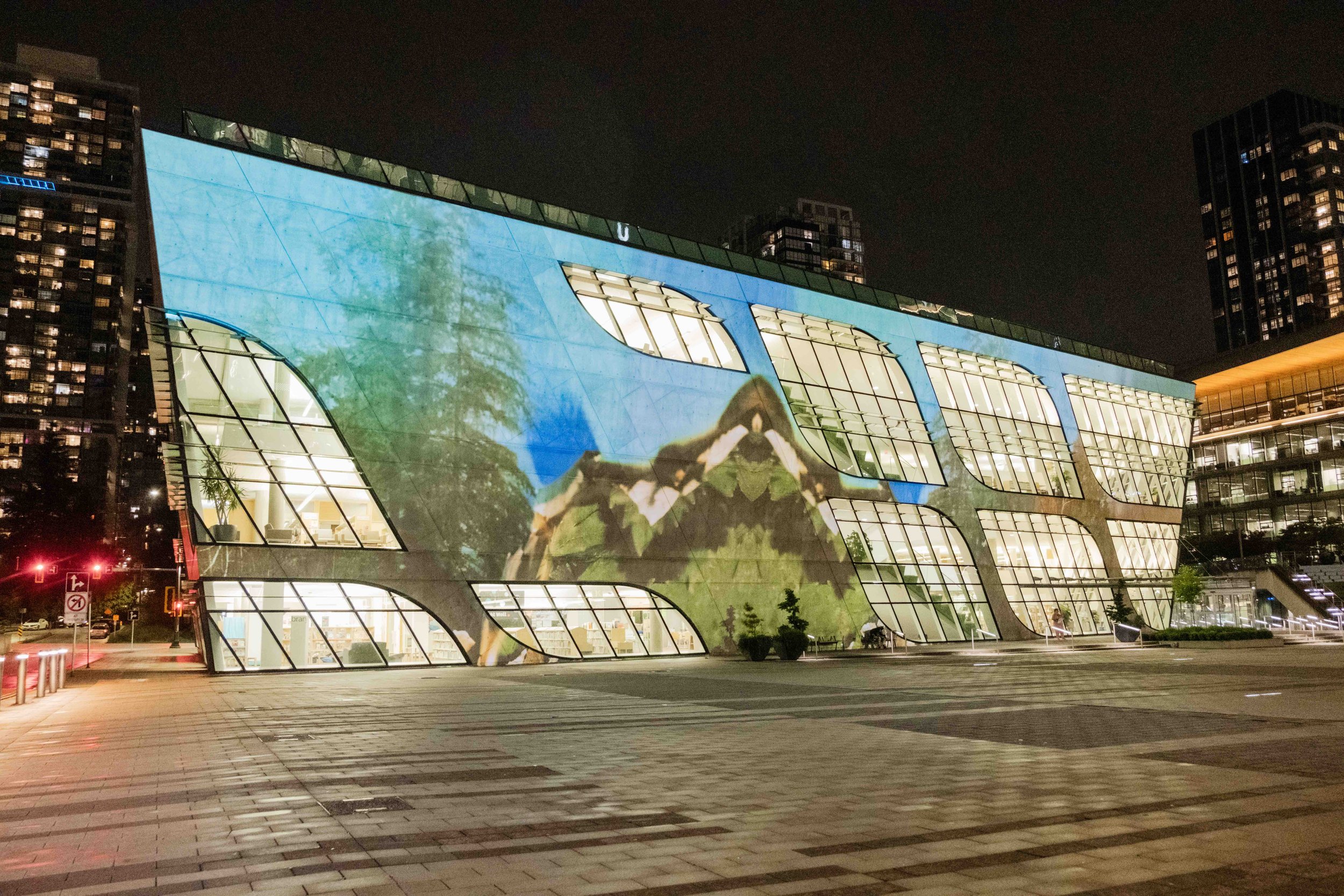Stir ’Splainer: 3 artists give an ancient medium new life in Mosaic Revival
North Van Arts exhibition features contemporary works by Daryl Lynne Wood, Lilian Broca, and Maria Abagis
Lilian Broca with two artworks in her “Mary Magdalene” series, The Anointing (left) and The Sacred Union, both composed of Venetian smalti, gold smalti, and millefiori on aluminum honeycomb panel.
North Van Arts presents Mosaic Revival: Three Contemporary Expressions at CityScape Community ArtSpace from May 2 to June 6
THE ORIGINS OF MOSAICS can be traced back thousands of years. Many of the earliest examples of the art form appeared in the third millennium B.C., when Mesopotamian temples were adorned with pieces made of coloured stones, seashell fragments, and ivory shards.
North Van Arts is paying homage to that rich history with Mosaic Revival: Three Contemporary Expressions, a new exhibition that highlights works by local artists Daryl Lynne Wood, Lilian Broca, and Maria Abagis.
Wood is a mosaic artist who incorporates experimental materials into her practice. She has exhibited her work locally and abroad, including with the Society of American Mosaic Artists and the British Association for Modern Mosaic. Broca creates large mosaic pieces that address contemporary societal issues through historical iconography. Abagis, meanwhile, cuts traditional materials into unique shapes; she recently had one of her mosaic works displayed at the Rencontres Internationales de Mosaïque in Chartres, France.
The upcoming exhibition traces “the journey from the ancient historical root of mosaics to contemporary cutting-edge explorations and expressions,” Wood tells Stir. Works on display at CityScape Community ArtSpace draw on the earliest iterations of the form, modernizing it with personal flair.
Opening night of Mosaic Revival is May 1 from 6 pm to 8 pm, and there will also be an artist talk on May 24 from 2 pm to 4 pm. Ahead of the launch, Stir connected with Wood, Broca, and Abagis to find out a bit more about the works they’ll be showing at the exhibition. Here’s what they had to say.
Maria Abagis’s Remembering All the Light, smalti, gold, shale, and other stone.
Maria Abagis
Remembering All the Light
“Even before I created my first mosaic, I was drawn to this art form. I love how certain materials and their placement play with the light, creating an ethereal type of dance. I love the textures; I love how you can create flow and movement to convey tension or emotion. I love how it can feel healing; not only are you taking broken pieces and bringing them back together to create something that didn’t exist before, but the mere act of meticulously cutting and placing tesserae feels meditative.
“Remembering All the Light is born out of deep grief and loss. I had recently lost my father. His passing and the months leading up to it shattered me. My father was a beautiful, kind, and gentle soul; he was all light. I have many painful memories of his final months, but it is that beautiful light that shines through. That is what I hold on to.
“The dark sections in this piece represent the disease and its devastating impact. The centre, made of glass (smalti) and gold, represents his kindness, warmth, and light.”
Daryl Lynne Wood’s Waiting to Be Born, gold and silver smalti, stained glass, mirror, pyrite.
Daryl Lynne Wood
Waiting to Be Born
“Waiting to Be Born explores the idea of the big-bang theory of particles in space being drawn together by gravity, and by whatever divine inspiration exists in the universe, to create our Earth. I decided to use the power of imagination to draw together fragments in my studio to create spheres within a shape loosely representing the symbol for infinity. When we look up at the sky, I imagine all the stars and planets being born and dying, but leaving us their light.
“My mosaic process always involves exploration and experiment. I love to bend the substrates I work on and also bend ideas to create new ways of seeing. I believe in the idea of “mind in matter”, where one can choose various materials to express an idea. And at the same time, some materials seem to tell a story of their own—such as lava rocks, which have been created by powerful forces in nature.”
Lilian Broca’s The Sacred Union from her “Mary Magdalene” series, Venetian smalti, gold smalti, and millefiori on aluminum honeycomb panel.
Lilian Broca
The Sacred Union, “Mary Magdalene” series
“My perspective in creating this narrative mosaic series is the same as in all my previous works: woman’s perspective. As such, I feel Mary Magdalene needs to be brought back to the high social status she held during the time of her life with Jesus, but sadly, severely diminished after he died.
“In the last two thousand years, we have been left with almost exclusively masculine achievements immortalized as heroes in monumental mosaics and other permanent materials. In order to give Mary Magdalene an equal cultural value to that of the honoured men, I decided to offer her the same veneration and acceptability seen in the profuse and extravagant representation of male heroes in mosaic art we inherited from distant times. This I feel I achieve by using monumental sizes for my mosaic panels and costly material for their execution, such as hand-made Venetian glass, gold, and semiprecious stones.
“In employing mosaic as a means to tell Mary Magdalene’s story, I demonstrate that the material perfectly suits our times; although having been around for millennia, mosaic shares much in common with the present computer technology. Like the computerized image, each tessera, each minuscule particle of a glass mosaic, serves the same function as a pixel. It is these glass fragments, like the pixels, that I employ to construct my story and convey my intent and meaning based on my life experience and psychological awareness.
“For the unifying motif in this series I chose a composition we see in illuminated manuscript pages. Each panel represents a page which depicts a scene in Mary Magdalene’s life along with an ancient language spoken during the first century in the Galilee and other geographical areas where Christianity was first adopted.” ![]()




























